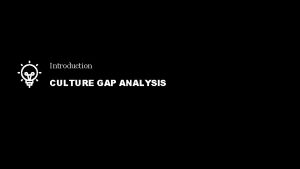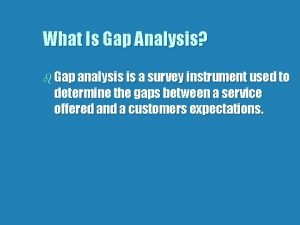Introduction CULTURE GAP ANALYSIS INTRODUCTION The culture gap






- Slides: 6

Introduction CULTURE GAP ANALYSIS

INTRODUCTION The culture gap analysis tool supports you in analysing how your current company culture supports the adoption of circular business models, and in identifying activities to bridge identified culture gaps. 1. Write down company-level cultural aspects (values, mindsets, behaviours) you think are relevant for the circular business model you consider Illustration of the tool Purpose Culture gap analysis 3. Summarise key planning and engagement-related activities that are required to bridge the identified culture gaps in your organisation Supporting materials Instructions 2. Assess your maturity level in those cultural aspects Chapter 5: How to design the transformation journey? Key building blocks of culture Examples of cultural aspects supporting circularity Illustrative playbook pages – please refer to the entire chapter for support. 2

EXAMPLE Culture gap analysis Example value: Customercentricity Example behaviour: Apply circular design criteria Example mindset: Repairing a product or component is better than producing a new one Example planning-related activities: • Identify change management lead/champion • Develop future-state vision of company culture • Plan culture change programme, including key activities and milestones Example engagement-related activities: • Start internal communications around change programme • Organise kick-off event • Conduct regular status update sessions • Develop supporting incentives 3

Tool CULTURE GAP ANALYSIS

Culture Gap Analysis (1/2) 1. 2. Write down company-level cultural aspects (values, mindsets, behaviours) you think are relevant for the circular business model you consider Assess your maturity level in those cultural aspects. Values Maturity level Example: Sustainability Not lived in company Partly lived At core of culture Mindset Maturity level Example: Things that increase client value are prioritised Not lived in company Partly lived At core of culture Behaviours Maturity level Example: Share know-how and experience across functions Not lived in company Partly lived At core of culture

Culture Gap Analysis (2/2) 1. Write down planning and engagement-related activities that are required to bridge the identified culture gaps in your organisation. What activities are required for planning the culture change in your organisation? What activities are required for engaging your organisation in the culture change?










